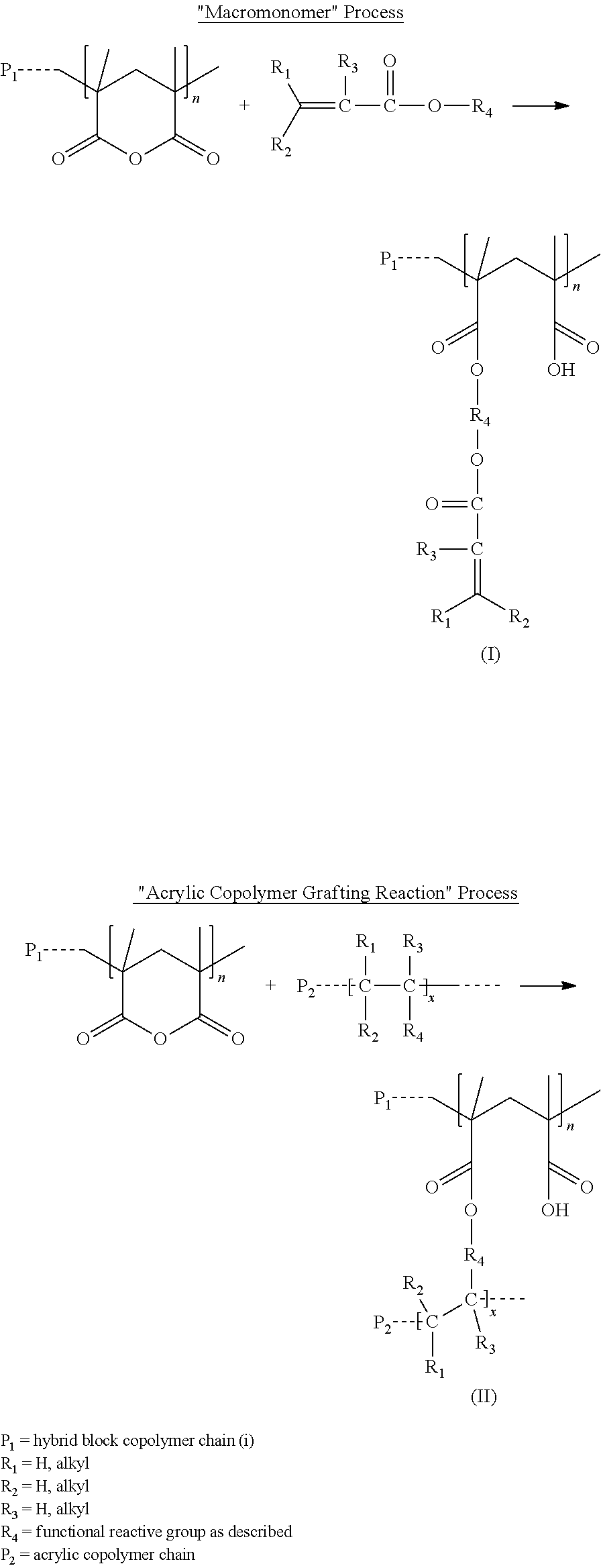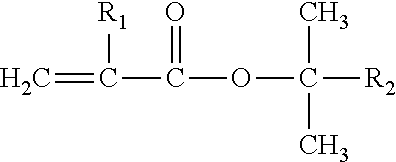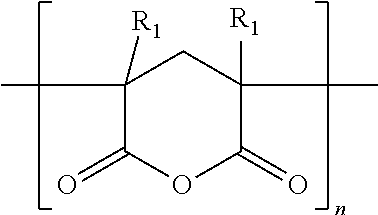Polymer Composition prepared from acrylic polymer grafted with a functionalized block copolymers
a polymer composition and functionalized block technology, applied in the direction of adhesives, adhesive types, epoxy resin adhesives, etc., can solve the problems of not revealing contact adhesives and coatings, affecting the adhesion of generally deficient adhesives to low energy surfaces. , to achieve the effect of improving adhesion to low energy surfaces, improving cohesive strength and flow resistance, and improving uv weathering and heat aging stability
- Summary
- Abstract
- Description
- Claims
- Application Information
AI Technical Summary
Benefits of technology
Problems solved by technology
Method used
Image
Examples
example 1
Preparation of Block Copolymers: Polymer #1, Polymer #2, Polymer #3
[0129]Polymer #1 was polymerized in the solvent mixture comprising 90% cyclohexane and 10% diethyl ether. Styrene was polymerized in the step I reactor and the living polymer was transferred to the step II reactor for sequential polymerization of butadiene followed by tert-butyl methacrylate (“TBMA”). The polymerization was terminated with methanol. 1.61 kg of TBMA and 37.5 kg of total monomer were charged for a target polymer TBMA content of 4.3% wt. The peak molecular weights in polystyrene equivalents were characterized by GPC with UV detector at each step: 7,054 after styrene polymerization, 122,425 after BD polymerization, and a mixture of 67% of a material with 127,043 molecular weight and 33% of a species with 250,264 molecular weight after TBMA polymerization. The reaction mixture was analyzed by NMR after TBMA polymerization and shown to contain no unreacted monomer within detection limits. The polymer was h...
example 1a
[0135]Polymer #4 is an S-EB-TBMA triblock copolymer with a polystyrene block molecular weight of 6,695 (Molecular weight is measured according to the method in Example 1, peak molecular weights in polystyrene equivalents characterized by GPC). The S-EB block molecular weight of 99,184 and the peak molecular weight of the full molecule with the TBMA is 102,800. The TBMA content is about 13 wt % and the polystyrene content is 9 wt %. The GPC analysis revealed 31% of a species with 250,264 molecular weight after TBMA polymerization.
##ic example 2
Prophetic Example 2
Toughened Epoxy Composition
[0136]270 grams of aromatic epoxy resin, the diglycidyl ether of bis phenol A, having an epoxide equivalent weight of 190 (Epon 828 from Hexion) is heated to 130° C. in a 400 ml beaker on a hot plate. 30 grams of S-EB-MAAn (extruded Polymer #2) is mixed in using a Silverson Model L2Air high shear mixer. After the polymer is mixed in to the resin, the temperature is raised to 190° C. and mixing is continued for 30 minutes. This rubber modified epoxy resin at room temperature is a hazy, thick liquid.
[0137]90 grams of the rubber modified epoxy resin is mixed with 10 grams of toluene. This is mixed with 130 grams of an aliphatic polyamine adduct having an amine equivalent weight of 200 (Curing Agent C111 from Hexion). The composition is coated onto a steel panel. After one week cure at room temperature, the composition is a coating having good impact resistance.
PUM
| Property | Measurement | Unit |
|---|---|---|
| glass transition temperature | aaaaa | aaaaa |
| elastomeric properties | aaaaa | aaaaa |
| temperatures | aaaaa | aaaaa |
Abstract
Description
Claims
Application Information
 Login to View More
Login to View More - R&D
- Intellectual Property
- Life Sciences
- Materials
- Tech Scout
- Unparalleled Data Quality
- Higher Quality Content
- 60% Fewer Hallucinations
Browse by: Latest US Patents, China's latest patents, Technical Efficacy Thesaurus, Application Domain, Technology Topic, Popular Technical Reports.
© 2025 PatSnap. All rights reserved.Legal|Privacy policy|Modern Slavery Act Transparency Statement|Sitemap|About US| Contact US: help@patsnap.com



